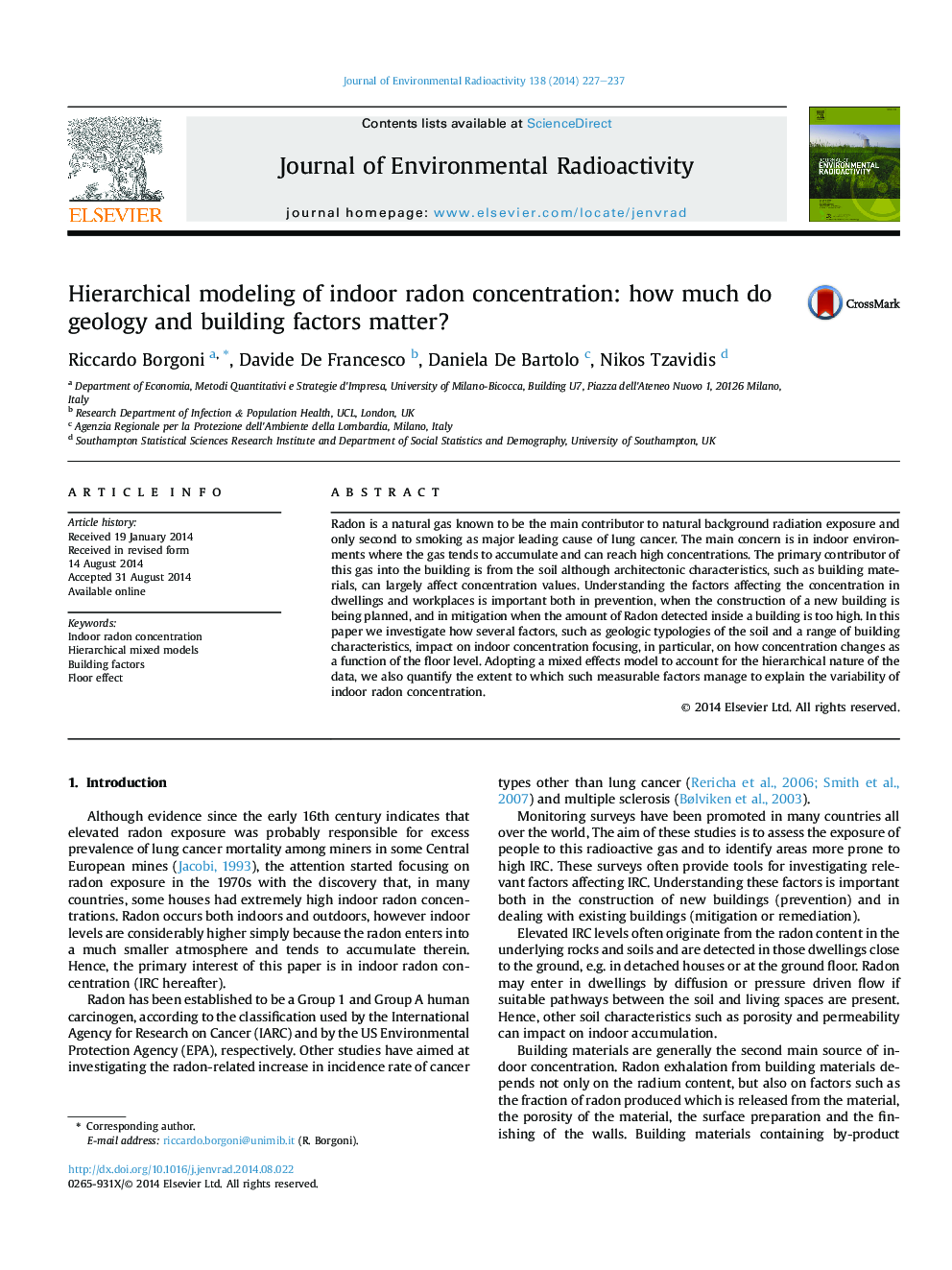| کد مقاله | کد نشریه | سال انتشار | مقاله انگلیسی | نسخه تمام متن |
|---|---|---|---|---|
| 8082802 | 1521595 | 2014 | 11 صفحه PDF | دانلود رایگان |
عنوان انگلیسی مقاله ISI
Hierarchical modeling of indoor radon concentration: how much do geology and building factors matter?
ترجمه فارسی عنوان
مدل سازی سلسله مراتبی غلظت رادون داخلی: چقدر زمین شناسی و عوامل ساختمان مهم هستند؟
دانلود مقاله + سفارش ترجمه
دانلود مقاله ISI انگلیسی
رایگان برای ایرانیان
کلمات کلیدی
غلظت رادون داخل سالن، الگوهای مخلوط سلسله مراتبی، عوامل ساختمان، اثر کف
ترجمه چکیده
رادون گاز طبیعی شناخته شده به عنوان اصلی اصلی در نور پس زمینه تابش طبیعی است و تنها دوم به سیگار کشیدن به عنوان عمده عامل اصلی سرطان ریه. نگرانی اصلی در محیط داخلی است که در آن گاز تمایل به انباشته شدن دارد و می تواند غلظت بالایی داشته باشد. نخستین مشارکت این گاز در ساختمان از خاک است، هرچند ویژگی های معماری مانند مصالح ساختمانی عمدتا بر میزان غلظت تاثیر می گذارد. درک عوامل موثر بر غلظت در محلات و محل کار در پیشگیری، هنگامی که ساخت و ساز یک ساختمان جدید در حال برنامه ریزی است، و در کاهش آن زمانی که مقدار رادون در داخل ساختمان بیش از حد بالا است، مهم است. در این مقاله، ما بررسی می کنیم که چگونه چندین عامل، مانند نوع شناسی زمین شناسی خاک و طیف وسیعی از ویژگی های ساختمان، بر تمرکز تمرکز در محیط تاثیر می گذارد، به ویژه اینکه چگونه تمرکز تغییر می کند به عنوان عملکرد سطح کف. با در نظر گرفتن ماهیت سلسله مراتبی داده های مدل های مختلف مخلوط، ما همچنین میزان اندازه گیری عوامل قابل اندازه گیری برای توضیح تغییرات غلظت رادون داخلی را تعیین می کنیم.
موضوعات مرتبط
مهندسی و علوم پایه
مهندسی انرژی
انرژی هسته ای و مهندسی
چکیده انگلیسی
Radon is a natural gas known to be the main contributor to natural background radiation exposure and only second to smoking as major leading cause of lung cancer. The main concern is in indoor environments where the gas tends to accumulate and can reach high concentrations. The primary contributor of this gas into the building is from the soil although architectonic characteristics, such as building materials, can largely affect concentration values. Understanding the factors affecting the concentration in dwellings and workplaces is important both in prevention, when the construction of a new building is being planned, and in mitigation when the amount of Radon detected inside a building is too high. In this paper we investigate how several factors, such as geologic typologies of the soil and a range of building characteristics, impact on indoor concentration focusing, in particular, on how concentration changes as a function of the floor level. Adopting a mixed effects model to account for the hierarchical nature of the data, we also quantify the extent to which such measurable factors manage to explain the variability of indoor radon concentration.
ناشر
Database: Elsevier - ScienceDirect (ساینس دایرکت)
Journal: Journal of Environmental Radioactivity - Volume 138, December 2014, Pages 227-237
Journal: Journal of Environmental Radioactivity - Volume 138, December 2014, Pages 227-237
نویسندگان
Riccardo Borgoni, Davide De Francesco, Daniela De Bartolo, Nikos Tzavidis,
